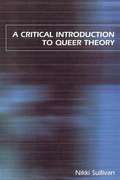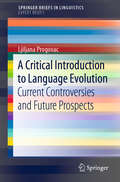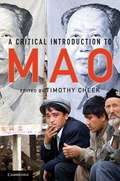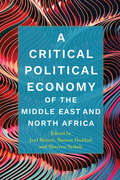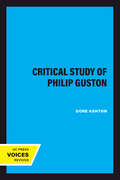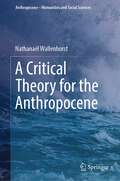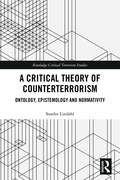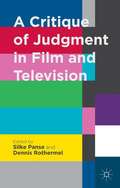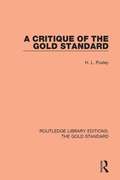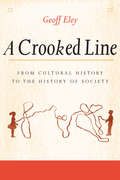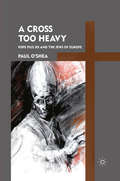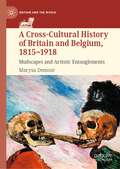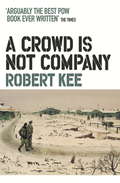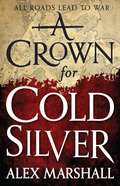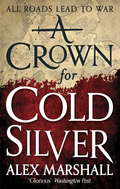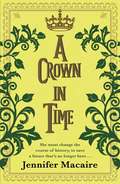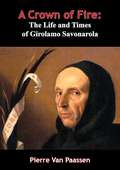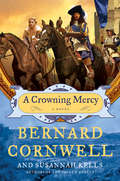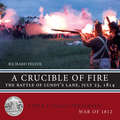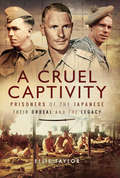- Table View
- List View
A Critical Introduction To Queer Theory
by Nikki SullivanA Critical Introduction to Queer Theory explores the ways in which sexuality, subjectivity and sociality have been discursively produced in various historical and cultural contexts. The book begins by putting gay and lesbian sexuality and politics in historical context and demonstrates how and why queer theory emerged in the West in the late twentieth century. Sullivan goes on to provide a detailed overview of the complex ways in which queer theory has been employed, covering a diversity of key topics including: race, sadomasochism, straight sex, fetishism, community, popular culture, transgender, and performativity. Each chapter focuses on a distinct issue or topic, provides a critical analysis of the specific ways in which it has been responded to by critics (including Freud, Foucault, Derrida, Judith Butler, Jean-Luc Nancy, Adrienne Rich and Laura Mulvey), introduces key terms, and uses contemporary cinematic texts as examples.
A Critical Introduction to Khomeini
by Arshin Adib-MoghaddamAs the architect of the Iranian Revolution of 1979, Ayatollah Khomeini remains one of the most inspirational and enigmatic figures of the twentieth century. The revolution placed Iran at the forefront of Middle East politics and of the Islamic revival. Twenty years after his death, Khomeini is revered as a spiritual and political figurehead in Iran and in large swathes of the Islamic world, while in the West he is remembered by many as a dictator and as the instigator of Islamist confrontation. Arshin Adib-Moghaddam brings together both distinguished and emerging scholars in this comprehensive volume, which covers all aspects of Khomeini's life and critically examines Khomeini the politician, the philosopher, and the spiritual leader. The book details Khomeini's early years in exile from Iran, the revolution itself, and events that took place thereafter including the hostage crisis and the Iran-Iraq war. Lastly, the book considers his legacy in Iran where Khomeini's image has been used by both reformist and conservative politicians to develop their own agendas and further afield in other parts of the Islamic world and in the West. Written by scholars from varying disciplinary backgrounds, the book will prove invaluable to students and general readers interested in the life and times of Khomeini and the politics of Islam that he inspired.
A Critical Introduction to Language Evolution: Current Controversies And Future Prospects (Springerbriefs In Linguistics Ser.)
by Ljiljana ProgovacThis book provides a critical introduction to the current views and controversies regarding language evolution. It sheds new light on hot topics such as: How ancient is language? Did Neanderthals have some form of language? Did language evolve gradually and incrementally, through stages, or suddenly, in one leap, in all its complexity? Does language evolution involve natural selection or not? This book is essential reading for scholars and students interested in language evolution, especially those in the fields of linguistics, psychology, biology, anthropology, and neuroscience.
A Critical Introduction to Mao
by Timothy CheekMao Zedong's political career spanned more than half a century. The ideas he championed transformed one of the largest nations on earth and inspired revolutionary movements across the world. Even today Mao lives on in China, where he is regarded by many as a near-mythical figure, and in the West, where a burgeoning literature continues to debate his memory. In this book, leading scholars from different generations and around the world offer a critical evaluation of the life and legacy of China's most famous - some would say infamous - son. The book brings the scholarship on Mao up to date, and its alternative perspectives equip readers to assess for themselves the nature of this mercurial figure and his significance in modern Chinese history.
A Critical Political Economy of the Middle East and North Africa (Stanford Studies in Middle Eastern and Islamic Societies and Cultures)
by Joel Beinin, Bassam Haddad, and Sherene SeikalyThis book offers the first critical engagement with the political economy of the Middle East and North Africa. Challenging conventional wisdom on the origins and contemporary dynamics of capitalism in the region, these cutting-edge essays demonstrate how critical political economy can illuminate both historical and contemporary dynamics of the region and contribute to wider political economy debates from the vantage point of the Middle East. Leading scholars, representing several disciplines, contribute both thematic and country-specific analyses. Their writings critically examine major issues in political economy—notably, the mutual constitution of states, markets, and classes; the co-constitution of class, race, gender, and other forms of identity; varying modes of capital accumulation and the legal, political, and cultural forms of their regulation; relations among local, national, and global forms of capital, class, and culture; technopolitics; the role of war in the constitution of states and classes; and practices and cultures of domination and resistance. Visit politicaleconomyproject.org for additional media and learning resources.
A Critical Study of Philip Guston
by Dore AshtonThis title is part of UC Press's Voices Revived program, which commemorates University of California Press’s mission to seek out and cultivate the brightest minds and give them voice, reach, and impact. Drawing on a backlist dating to 1893, Voices Revived makes high-quality, peer-reviewed scholarship accessible once again using print-on-demand technology. This title was originally published in 1976.This title is part of UC Press's Voices Revived program, which commemorates University of California Press’s mission to seek out and cultivate the brightest minds and give them voice, reach, and impact. Drawing on a backlist dating to 1893, Voices Revived</DIV
A Critical Theory for the Anthropocene (Anthropocene – Humanities and Social Sciences)
by Nathanaël WallenhorstThis volume, which is rooted in biogeophysical studies, addresses conceptions of political action in the Anthropocene and the tension between a desire to accomplish the Promethean project of modernity and a post-Promethean approach. This work explores the idea of an anthropological mutation of political consolidation from a “post-Promethean togetherness”, to creating the capacity to act together. The political thinking of the human condition developed by Hannah Arendt is important here as a resource for thinking about humanity in terms of human adventure. This has three dimensions: hubris, the world and coexistence referring respectively to the logic of profit of the homo oeconomicus, the logic of responsibility of the homo collectivus and the logic of the hospitality of the homo religatus. The intellectual and political attitude outlined in this book is an extension of critical theory: the work also puts forward a critique of what poses a problem in our relationship to the world and suggests how to overcome it, the ultimate goal being social transformation. The author propose an uprising and an anthropological consolidation of politics based on the revitalization that is brought about by the sharing of a conviviality both between humans and with what is non-human. The identification of conviviality as an educational paradigm to survive the Anthropocene gives us the much needed reason for hope despite this heritage of the Anthropocene. In addition to Arendtian thinking, this critical theory for the Anthropocene draws on the political thinking of several contemporary authors including Maurice Bellet, Hartmut Rosa, Andreas Weber, Dominique Bourg, and Christian Arnsperger. This volume is of interest to researchers in the Anthropocene.
A Critical Theory of Counterterrorism: Ontology, Epistemology and Normativity (Routledge Critical Terrorism Studies)
by Sondre LindahlThis book offers a theory and model of counterterrorism based on emancipation and non-violence. Critical Terrorism Studies (CTS) scholars have produced wide-ranging and rich critiques of terrorism-related research, as well as state counterterrorism policies and practices. This work aims to fill in a gap in the current literature by constructing an original and specifically CTS model of counterterrorism. The model outlines the basic assumptions, priorities, principles, strategies and tactics, measures and evaluation of counterterrorism. It challenges prevalent models of counterterrorism through a radical rethinking of the ontology, epistemology and the agenda of counterterrorism. The model aims to prevent future acts of terrorism by (1) re-conceptualising how we study and understand terrorism, and; (2) suggesting that our efforts to counter and prevent terrorism must commensurate with the goals we want to achieve. Essentially, this involves a commitment to emancipation, and a rejection of violence as a tool. The second part of the book is a case study of Norwegian counterterrorism which shows how the theory and model developed in the book can be used. This is the first substantial analysis of Norwegian counterterrorism in almost ten years, and produces encouraging findings which support the potential for non-violent solutions to terrorism. This book will be of particular interest to students of terrorism and counterterrorism, critical security studies, and international relations in general.
A Critical Theory of Police Power: The Fabrication of the Social Order
by Mark NeocleousPutting police power into the centre of the picture of capitalismThe ubiquitous nature and political attraction of the concept of order has to be understood in conjunction with the idea of police. Since its first publication, this book has been one of the most powerful and wide-ranging critiques of the police power. Neocleous argues for an expanded concept of police, able to account for the range of institutions through which policing takes place. These institutions are concerned not just with the maintenance and reproduction of order, but with its very fabrication, especially the fabrication of a social order founded on wage labour. By situating the police power in relation to both capital and the state and at the heart of the politics of security, the book opens up into an understanding of the ways in which the state administers civil society and fabricates order through law and the ideology of crime. The discretionary violence of the police on the street is thereby connected to the wider administrative powers of the state, and the thud of the truncheon to the dull compulsion of economic relations.
A Critique of Judgment in Film and Television
by Silke Panse Dennis RothermelA Critique of Judgment in Film and Television is a response to a significant increase of judgment and judgmentalism in contemporary television, film, and social media by investigating the changing relations between the aesthetics and ethics of judgment.
A Critique of the Gold Standard (Routledge Library Editions: The Gold Standard #5)
by H. L. PuxleyOriginally published in 1933 this book discusses the inadequacy of ‘orthodox Gold Standard theory’ in the light of post-war monetary phenomena. In demonstrating that the Gold Standard had broken down the book explains that the Quantity Theory of Money is an inaccurate explanation of what happens over short periods and that the determining factor in the rise or fall of prices is the Velocity of Circulation. The book makes a plea for a workable Gold Standard operated by an international consortium of Central Banks.
A Crooked Line
by Geoff EleyEley (U. of Michigan), a self-described radical historian, looks back on his career as historian, while analyzing the great theoretical and methodological debates that roiled the field since the late 1960s and considering their contributions to and false paths for the field. Running through the narrative is an explicit awareness of the connection of these debates to politics outside the academy. Annotation ©2006 Book News, Inc. , Portland, OR (booknews. com)
A Cross Too Heavy: Pope Pius XII and the Jews of Europe
by Paul O'SheaThe papacy of Pius XII (1939-1958) has been a source of near-constant criticism and debate since his death, particularly because of his alleged silence during the Holocaust. Paul O'Shea examines his little-studied pre-papal life to demonstrate that Pius was neither an anti-Semitic villain nor a 'lamb without stain. '
A Cross-Cultural History of Britain and Belgium, 1815–1918: Mudscapes and Artistic Entanglements (Britain and the World)
by Marysa DemoorThis book highlights the ways in which Britain and Belgium became culturally entangled as a result of their interaction in the period between the Napoleonic Wars and the First World War. In the course of the nineteenth century, the battlefields of Waterloo and Ypres in Belgium became veritable burial grounds for generations of dead British military, indirectly leading to the most intensive ties between the two countries. By exploring this twofold path, the author uncovers a series of cross-influences and creative similarities within the Belgo-British artistic community, and explores the background against which the British national identity was constructed. Revealing unknown links between some of the most famous artists on both sides of the channel, such as D.G. Rossetti and Jan Van Eyck; Christina Rossetti and Fernand Khnopff; John Millais and Pieter Breughel, and Lewis Carroll and Quentin Massys, the book emphasises an artistic cross-fertilisation that can be found within battlefield literature throughout the nineteenth century, including examples from the likes of William M. Thackeray, Frances Trollope and Charlotte Brontë. Providing a rich intercultural history of Belgo-British relations after the battle of Waterloo, this interdisciplinary book will appeal to scholars and students researching history, literature, art and cultural studies.
A Crowd Is Not Company
by Robert KeeJournalist and broadcaster Robert Kee was an RAF bomber pilot in the Second World War. When his plane was shot down over Nazi-occupied Holland, he was captured and spent three years and three months in a German POW camp. From the beginning he was intent on escape. After several false starts, he finally made it. First published in 1947 as a novel, but now revealed to be an autobiography, A Crowd Is Not Company recounts Kee's experiences as a prisoner of war and describes in compelling detail his desperate journey across Poland - a journey that meant running the gauntlet of Nazism.
A Crowd Is Not Company
by Robert KeeJournalist and broadcaster Robert Kee was an RAF bomber pilot in the Second World War. When his plane was shot down over Nazi-occupied Holland, he was captured and spent three years and three months in a German POW camp. From the beginning he was intent on escape. After several false starts, he finally made it. First published in 1947 as a novel, but now revealed to be an autobiography, A Crowd Is Not Company recounts Kee's experiences as a prisoner of war and describes in compelling detail his desperate journey across Poland - a journey that meant running the gauntlet of Nazism.
A Crown for Cold Silver (The Crimson Empire #1)
by Alex Marshall"It was all going so nicely, right up until the massacre."Twenty years ago, feared general Cobalt Zosia led her five villainous captains and mercenary army into battle, wrestling monsters and toppling an empire. When there were no more titles to win and no more worlds to conquer, she retired and gave up her legend to history. Now the peace she carved for herself has been shattered by the unprovoked slaughter of her village. Seeking bloody vengeance, Zosia heads for battle once more, but to find justice she must confront grudge-bearing enemies, once-loyal allies, and an unknown army that marches under a familiar banner.FIVE VILLAINS. ONE LEGENDARY GENERAL. A FINAL QUEST FOR VENGEANCE.
A Crown for Cold Silver: Book One of the Crimson Empire (Crimson Empire #1)
by Alex MarshallCold Cobalt, the Banshee with a Blade, First Among Villains . . . Queen ZosiaWhen there were no more titles to win and no more worlds to conquer, the warrior queen Zosia faked her demise and gave up her legend to history. But when violence finds its way to her door years later, she must round up her adventuring companions - each surprised to see her alive - and set out for revenge.Time has not been kind to her old comrades, and some have only their own goals in mind. Not only that, but there's a young, beautiful and skilled general out there, gathering soldiers to her banner for a war against the deadliest of enemies. The girl is using a legend she did not earn, and calling herself by a name that was never hers - that of Zosia herself.
A Crown for Cold Silver: Book One of the Crimson Empire (Crimson Empire #1)
by Alex MarshallCold Cobalt, the Banshee with a Blade, First Among Villains . . . When there were no more titles to win and no more worlds to conquer, the warrior queen Zosia faked her demise and gave up her legend to history. But when violence finds its way to her door years later, she must round up her adventuring companions - each surprised to see her alive - and set out for revenge.Time has not been kind to her old comrades, and some have only their own goals in mind. Not only that, but there's a young, beautiful and skilled general out there, gathering soldiers to her banner for a war against the deadliest of enemies. The girl is using a legend she did not earn, and calling herself by a name that was never hers - that of Zosia herself.
A Crown in Time: She must rewrite history, or be erased from Time forever... (The Tempus U Time Travel series #1)
by Jennifer MacaireSince it was perfected in 2900, time travel has been reserved for an elite, highly trained few. However, on certain occasions, a Corrector is needed to rectify a mistake in the past.Do your job well, and you'll go down in history. Fail, and you will be erased from Time . . .For fans of Jodi Taylor, the first in an exciting new time-slip series, from author of the action-packed Time for Alexander series, Jennifer Macaire. A CROWN IN TIME will have you on the edge of your seat from the very first page . . .In the far future, a convicted criminal is given a chance at redemption. The Corrector Program at Tempus University is sending Isobel back in time, to the year 1270, to rewrite history.Her mission? To save the crown of France.If she follows the Corrector's Handbook everything should run smoothly. But soon, Isobel finds herself accompanying a hot-headed young noble on his way to fight the infidel in Tunis: a battle Isobel knows is fated to be lost.Isobel must fulfil her duty, knowing she can never return to her time, knowing one wrong move can doom the future, or doom her to be burned as a witch . . .Praise for Jennifer Macaire's Alexander series:'Fascinating . . . jam-packed with adventure and colour.' Jodi Taylor
A Crown in Time: She must rewrite history, or be erased from Time forever... (The\tempus U Time Travel Ser. #1)
by Jennifer MacaireSince it was perfected in 2900, time travel has been reserved for an elite, highly trained few. However, on certain occasions, a Corrector is needed to rectify a mistake in the past.Do your job well, and you'll go down in history. Fail, and you will be erased from Time . . .For fans of Jodi Taylor, the first in an exciting new time-slip series, from author of the action-packed Time for Alexander series, Jennifer Macaire. A CROWN IN TIME will have you on the edge of your seat from the very first page . . .In the far future, a convicted criminal is given a chance at redemption. The Corrector Program at Tempus University is sending Isobel back in time, to the year 1270, to rewrite history.Her mission? To save the crown of France.If she follows the Corrector's Handbook everything should run smoothly. But soon, Isobel finds herself accompanying a hot-headed young noble on his way to fight the infidel in Tunis: a battle Isobel knows is fated to be lost.Isobel must fulfil her duty, knowing she can never return to her time, knowing one wrong move can doom the future, or doom her to be burned as a witch . . .Praise for Jennifer Macaire's Alexander series:'Fascinating . . . jam-packed with adventure and colour.' Jodi Taylor
A Crown of Fire: The Life and Times of Girolamo Savonarola
by Pierre Van PaassenThe life of Savonarola and its place in the history of Italy and the Church has been subject to many interpretations. In this book Pierre van Paassen gives it the most balanced, entertaining, and factual treatment yet. Savonarola and Firenze (Florence) however are so inextricably bound together that the two must be discussed at one and the same time. Florence was at the height of her glory in the most brilliant phase of the Renaissance and herein the splendor and picturesqueness of that whole epoch is brought vividly to life. Mr. van Paassen traces Savonarola's youth and his teenage love for a girl in Ferrara, his hometown, and then his sudden decision (quite like Loyola's) to enter the Church. Following his novitiate Savonarola was called to Florence and immortality by Lorenzo the Magnificent. In this most exciting period of history the author traces his contacts with Lorenzo and the opposition, with the artists, Botticelli and Michelangelo, with Machiavelli, with the great Pope, Alexander VI, with Lucrezia, Cesare and the Sforza family. There is Savonarola's conversion of the whole city of Florence with the entire population walking in a procession of penitence. When the king of France invaded Italy Savonarola went out to meet him and thus saved the city while the rest of the country was ravaged by war.Mr. van Paassen examines Savonarola's ideas on democracy and freedom, on everyday questions, and his strange predictions and prophesies which came to be fulfilled. And finally, the accusation of heresy, the trial and torture, and the burning at the stake.Most books on Savonarola used the monk's career and death to belabor Pope Alexander VI and the Borgia family. Not so here: rather Mr. van Paassen's theme is that had Savonarola's counsel been heeded the Reformation would have taken place within, rather than outside, the Church.
A Crowning Mercy (Crowning Mercy #1)
by Bernard Cornwell Susannah KellsThe civil war that is tearing England asunder in the year 1643 has not yet touched Dorcas Slythe, a secretly rebellious young Puritan woman living in the countryside south of London. She aches to escape the safe, pious tyranny of her father--and the opportunity appears with the arrival of Toby Lazender, dashing scion of a powerful royalist family, who awakens her to her passionate destiny. Her adventure truly begins with the discovery of an intricately wrought gold seal--one of four that, when joined, will reveal a great secret. Suddenly grave danger lies before her--not from Cromwell's advancing armies, but from relentless enemies who covet the great treasure to which she now holds the key.
A Crucible of Fire: The Battle of Lundy's Lane, July 25, 1814
by Richard FeltoeFrom the Battle of Chippawa to Lundy’s Lane, A Crucible of Fire focuses on the period of the War of 1812 leading up to the siege on Fort Erie in September 1814. Following their invasion at Fort Erie and decisive victory at the Battle of Chippawa, an American army of over 5,000 men seemed poised to sweep across the Niagara frontier to Lake Ontario, link up with the American fleet, and complete the final expulsion of the British allied forces from Upper Canada. However, only a month later, the shattered remnants of this force were firmly on the defensive and feverishly digging in as the British advanced to begin the siege of Fort Erie. The fifth book in the Upper Canada Preserved series examines this pivotal period in the course of the War of 1812–1815 with particular emphasis on the events that led up to and took place at the Battle of Lundy’s Lane on July 25, 1814. Excerpts from original accounts, letters, and diaries and a series of new highly-detailed maps place readers on the field where they can follow the action as each phase of this decisive combat took place in the darkness of the night and within earshot of the Great Falls of Niagara.
A Cruel Captivity: Prisoners of the Japanese: Their Ordeal and The Legacy
by Ellie TaylorCarefully and sensitively researched, A Cruel Captivity describes the ordeals of, and lasting impact on, survivors of Japanese captivity.Differing in a number of respects from other moving POW accounts, this book covers the experiences of 22 servicemen from the Army, Royal Navy, RAF and volunteer forces who were held captive in numerous locations through South East Asia including Thailand, Burma, Hong Kong, the Spice Islands and Japan itself. Some had to endure the inhumane conditions during hazardous journeys on the hellships and all suffered appalling cruelty, starvation, disease and prolonged degradation on an epic scale. Yet these were the fortunate ones many thousands perished and their graves were unmarked.The book also examines the differing mental and physical effects that the prisoners captors cruel treatment had on them. The authors handling of the legacy of their experiences during the post-war years makes this moving book particularly important. For a full understanding of this dreadful aspect of the Second World War, A Cruel Captivity is a must-read.
